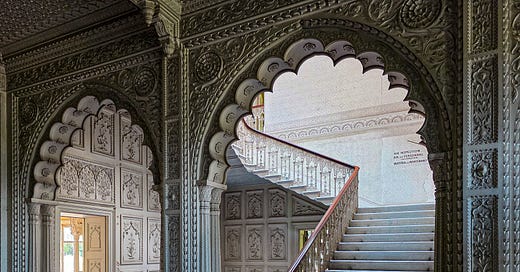A Punjabi Palace in Suffolk
In a quiet corner of Suffolk, just beyond the hedgerows and honey-stone cottages of Thetford Forest, stands a country house unlike any other in Britain.
From the outside, it looks like your rather standard 19th century Italianate country pile. Walk through the door, however, and you come face to face with the greatest Punjabi interiors in the United Kingdom.
This is Elveden Hall, once home to the last Maharaja of the Sikh Empire. And though few have heard of it, it may be the most remarkable house in England.
The Lion of the Punjab
To understand the story of Elveden, we need to go back a generation, to the old court of Lahore in modern-day Pakistan.
In 1799, a 19-year old charismatic young chieftain called Ranjit Singh from a small Sikh estate of Gujranwala captured Lahore, the greatest city in the Punjab. Over the next years, his rule spread to the edge of Sutlej in the east, to Kashmir and Peshawar in the north, and in Multan towards the South. For the first and only time in history, a ‘Sikh Empire’ would now stretch across a fifth of South Asia.
The Kingdom of Punjab not only saw a thriving trade in Kashmiri pashminas and Sialkoti silver, but also produced some brilliant works of fine art. New cities like Amritsar were built from scratch and a new Punjabi aristocracy sprang up.
Ranjit Singh’s formidable army of Frenchmen and American adventurers not only brought new norms of discipline in the military lines, but also newer traditions of gallantry medals and honours. The 'Sikh' army of Ranjit Singh included Russian, Spanish, Greek, Austrian, Turkish, Iranian, Afghan, and Scottish troops.
Nonetheless, the desecration of many mosques across Pakistan makes him a controversial figure in Pakistan today, just as Mughal desecration of several temples makes their legacy complicated in India today.
After the death of Maharaja Ranjit Singh in the summer of 1839, his son and heir Kharak Singh appointed Faqir Nur-ud-din, a prominent courtier of the Durbar, to supervise the construction of Ranjit's samadh (tomb/memorial) inside Lahore's Badami Bagh, just outside the fort.
But Kharak Singh did not remain Maharaja for long, and his death was followed by a chain of murders, internal political mayhem, and a disastrous war with the British. The samadh would only be finished in 1848, as the territories of Kashmir and Jalandhar were separated from Ranjit's erstwhile empire.
A few months later in 1849, a 'rebellion' in Multan would result in the official annexation of Ranjit Singh's kingdom.
The Last Maharaja of Punjab
Punjab was annexed by the East India Company when Ranjit Singh’s son Duleep was only ten, and as an infant he was forced to sign away the Kohinoor and Punjab to the British, and Kashmir to the Dogras.
Having grown up in Lahore Fort, Duleep was suddenly ripped away from his mother and sent to live as a political hostage in England.
Keep reading with a 7-day free trial
Subscribe to Travels of Samwise to keep reading this post and get 7 days of free access to the full post archives.













